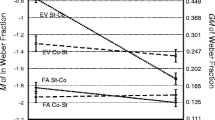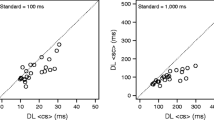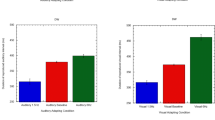Summary
Methods for the measurement of time-errors (TEs) in the comparison of successive stimulus magnitudes are discussed. Combining a Thurstonian scaling method with the assumption of a fixed subjective width of the “equal” category, independent of stimulus level, a ratio scale for subjective differences within pairs of successive stimuli is derived. In a tone duration comparison experiment, with the TE defined in the terms of these subjective duration differences, data from four experimental groups were compared, the groups using different modes of judging and responding. Only minor effects of this factor were found, and hence it is concluded that the TE is a true perceptual phenomenon rather than an effect of response bias, criterion bias, or mediating verbal responses to the absolute level of stimulation. The quantitative results are interpreted in terms of a general model for the comparison of successive stimuli, employing the concepts of adaptation and differential weighting of sensation magnitudes.
Similar content being viewed by others
References
Angell, F.: Review of Martin and Müller's “Zur Analyse der Unterschieds-empfindlichkeit”. Amer. J. Psychol. 11, 266–271 (1899)
Audley, R.J., Wallis, C.P.: Response instructions and the speed of relative judgment. I. Some experiments on brightness discrimination. Brit. J. Psychol. 55, 59–73 (1964)
Bartlett, R.J.: Measurement in psychology. Advancement of Sci. 1, 422–441 (1939)
Björkman, M., Holmkvist, O.: On the time-order error in the construction of a subjective time scale. Scand. J. Psychol. 1, 7–13 (1960)
Cattell, J. McK.: On errors of observation. Amer. J. Psychol. 5, 285–293 (1893)
Chandler, J.P.: STEPIT — Finds local minima of a smooth function of several parameters. Behav. Sci. 14, 81–82 (1969) (CPA 312)
Eisler, H.: Empirical test of a model relating magnitude and category scales. Scand. J. Psychol. 3, 88–96 (1962)
Eisler, H.: Possible implications of a non-constant subjective zero in the psychophysical power function. Perc. mot. Skills 16, 778 (1963)
Eisler, H.: The connection between magnitude and category scales and direct and indirect scaling methods. Psychometrika 30, 271–289 (1965)
Eisler, H.: Subjective duration and psychophysics. Psychol. Rev. 82, 429–450 (1975)
Eisler, H.: Experiments on subjective duration 1868–1975. A collection of power function exponents. Psychol. Bull. 83, 1154–1171 (1976)
Eisler, H., Ottander, C.: On the problem of hysteresis in psychophysics. J. exp. Psychol. 65, 530–536 (1963)
Ekman, G.: Discriminal sensitivity on the subjective continuum. Acta Psychol. 12, 233–243 (1956)
Ekman, G.: Weber's law and related functions. J. Psychol. 47, 343–352 (1959)
Engen, T.: Psychophysics. 1. Discrimination and detection. In: Kling, L.A., Riggs, J.W. (Eds.): Woodworth & Schlosberg's experimental psychology, 3rd ed. New York: Holt 1971
Fechner, G.T.: Elemente der Psychophysik. Leipzig: Breitkopf & Hārtel 1860
Fraisse, P.: Les erreurs constantes dans la reproduction de courts intervalles temporels. Archives de Psychologie 32, 161–176 (1948)
Galanter, E.: Contemporary psychophysics. In: New directions in psychology. New York: Holt 1962
Garner, W.R., Hake, H., Eriksen, C.W.: Operationism and the concept of perception. Psychol. Rev. 63, 144–159 (1956)
Glenn, W.A., David, H.A.: Ties in paired-comparison experiments using a modified Thurstone-Mosteller model. Biometrics 16, 86–109 (1960)
Green, D.M., Swets, J.A.: Signal detection theory and psychophysics. New York: Wiley 1966
Greenberg, M.G.: A modification of Thurstone's law of comparative judgment to accomodate a judgment category of “equal” or “no difference”. Psychol. Bull. 64, 108–112 (1965)
Guilford, J.P.: Psychometric methods, 2nd ed. New York: McGraw-Hill 1954
Gulliksen, H.: Comparatal dispersion, a measure of accuracy of judgment. Psychometrika 23, 137–150 (1958)
Harris, W.P.: A revised law of comparative judgment. Psychometrika 22, 189–198 (1957)
Hellström, Å.: On time-errors and psychophysical measurement. Unpublished thesis, University of Stockholm 1972
Hellström, Å.: Differential sensation weighting as the basic cause of time-errors. Rep. Dep. Psychol., Univ. Stockholm, No. 498 (1977a)
Hellström, Å.: Factors producing and not producing time-errors. An experiment with loudness comparisons. Rep. Dep. Psychol., Univ. Stockholm, No. 497 (1977b)
Hellström, Å.: On the nature of the time-error. Rep. Dep. Psychol., Univ. Stockholm, Suppl. 38 (1977c)
Helson, H.: Adaptation-level theory. New York: Harper & Row 1964
Jamieson, D.G., Petrusic, W.M.: Presentation order effects in duration discrimination. Perc. Psychophys. 17, 197–202 (1975)
John, I.D.: A common mechanism mediating the time-order error and the cross-over effect in comparative judgments of loudness. Austral. J. Psychol. 27, 51–60 (1975)
Kämpfe, B.: Beiträge zur experimentellen Prüfung der Methode der richtigen und falschen Fälle. Phil. Stud. 8, 549–591 (1893)
Karlin, L.: The influence of equality judgments on the constant error. J. exp. Psychol. 42, 300–303 (1951)
Lauenstein, O.: Ansatz zu einer physiologischen Theorie des Vergleichs und der Zeitfehler. Psychol. Forsch. 17, 130–177 (1933)
Luce, R.D., Galanter, E.: Discrimination. In: Luce, R.D., Bush, R.R., Galanter, E. (Eds.): Handbook of mathematical psychology. New York: Wiley 1963
Martin, L.J., Müller, G.E.: Zur Analyse der Unterschiedsempfindlichkeit. Leipzig: Barth 1899
McGavren, M.: Memory of brief auditory durations in comparison discriminations. Psychol. Record 15, 249–260 (1965)
Michels, W.C., Helson, H.: A quantitative theory of time-order effects. Amer. J. Psychol. 67, 327–334 (1954)
Mikkonen, V.: On the retention of perceptual quantities. Comm. Hum. Litt., Soc. Scient. Fenn. 44, Whole No. 3 (1969)
Morikiyo, Y.: Time-order error in the successive comparison of tones — an examination by adaptation-level theory. Jap. J. Psychol. 30, 46–55 (1959)
Nakajima, Sei: On the time-error in the successive comparison of time. Jap. J. Psychol. 21, 36–45 (1951)
Nakajima, Shinshu: The time-error in the successive comparison of tonal durations. Jap. J. Psychol. 29, 18–28 (1958)
Needham, J.G.: The time error in comparison judgments. Psychol. Bull. 31, 229–243 (1934)
Needham, J.G.: The effect of the time-interval upon the time-error at different intensive levels. J. exp. Psychol. 18, 530–543 (1935)
Olson, C.L., Ogilvie, J.C.: The method of constant stimuli with two or more categories of response. J. math. Psychol. 9, 320–338 (1972)
Peak, H.: The time order error in successive judgment and in reflexes: III Time error theories. Psychol. Rev. 47, 1–20 (1940)
Restle, F.: Psychology of judgment and choice. New York: Wiley 1961
Richards, W.: Time estimates measured by reproduction. Perc. mot. Skills 18, 929–943 (1964)
Sjöberg, L.: An empirical application of a new case of the law of comparative judgment. Scand. J. Psychol. 4, 97–107 (1963)
Sjöberg, L.: A study of four methods for scaling paired comparisons data. Scand. J. Psychol. 6, 173–185 (1965)
Sjöberg, L.: Successive intervals scaling of paired comparisons. Psychometrika 32, 297–308 (1967)
Sjöberg, L.: The dimensionality paradox in comparative judgment: A resolution. Scand. J. Psychol. 9, 97–108 (1968a)
Sjöberg, L.: Unidimensional scaling of multidimensional facial expressions. J. exp. Psychol. 78, 429–435 (1968b)
Sjöberg, L.: The dimensionality of similarity judgments. Amer. J. Psychol. 82, 441–456 (1969)
Sjöberg, L.: Uncertainty of comparative judgments and multidimensional structure. Multivar. behav. Res. 10, 207–218 (1975)
Stevens, S.S.: On the psychophysical law. Psychol. Rev. 64, 153–181 (1957)
Stevens, S.S.: Psychophysics (ed. by G. Stevens). New York: Wiley 1975
Stott, L.H.: Time-order errors in the discrimination of short tonal durations. J. exp. Psychol. 18, 741–766 (1935)
Tanaka, Y.: Determination of the point of subjective equality in the constant method procedure. Jap. Psychol. Res. 3, 193–194 (1961)
Tärnblom, S., Hellström, Å.: Time-errors for weight. Unpublished manuscript, University of Stockholm, 1963
Thurstone, L.L.: A law of comparative judgment. Psychol. Rev. 34, 273–286 (1927a)
Thurstone, L.L.: Psychophysical analysis. Amer. J. Psychol. 38, 368–389 (1927b)
Torgerson, W.S.: Theory and methods of scaling. New York: Wiley 1958
Vierordt, K.: Der Zeitsinn nach Versuchen. Tübingen: Laupp 1868
Wallis, C.P., Audley, R.J.: Response instructions and the speed of relative judgment. II. Pitch discrimination. Brit. J. Psychol. 55, 121–132 (1964)
Wickelgren, W.A.: Unidimensional strength theory and component analysis of noise in absolute and comparative judgments. J. math. Psychol. 15, 102–122 (1968)
Woodrow, H.: Weight discrimination with a varying standard. Amer. J. Psychol. 45, 391–416 (1933)
Woodrow, H.: Time perception. In: Stevens. S.S. (Ed.): Handbook of experimental psychology. New York: Wiley 1951
Woodruff, B., Jennings, D.L., Rico, N.L.: Time-error in lifted weights as affected by presentation order and judgment mode. Perc. Psychophys. 18, 98–104 (1975)
Woodworth, R.S., Schlosberg, H.: Experimental psychology, Rev. ed. New York: Holt 1954
Author information
Authors and Affiliations
Additional information
This investigation was supported by grants to the author from the University of Stockholm and from the Swedish Office of Administrative Rationalization and Economy (for computer time), and by grants to Mats Björkman and Hannes Eisler from the Swedish Council for Social Science Research, whose free consultation service at the Department of Statistics, University of Stockholm, also benefited the author.
Rights and permissions
About this article
Cite this article
Hellström, Å. Time errors are perceptual. Psychol. Res 39, 345–388 (1977). https://doi.org/10.1007/BF00308933
Received:
Issue Date:
DOI: https://doi.org/10.1007/BF00308933




